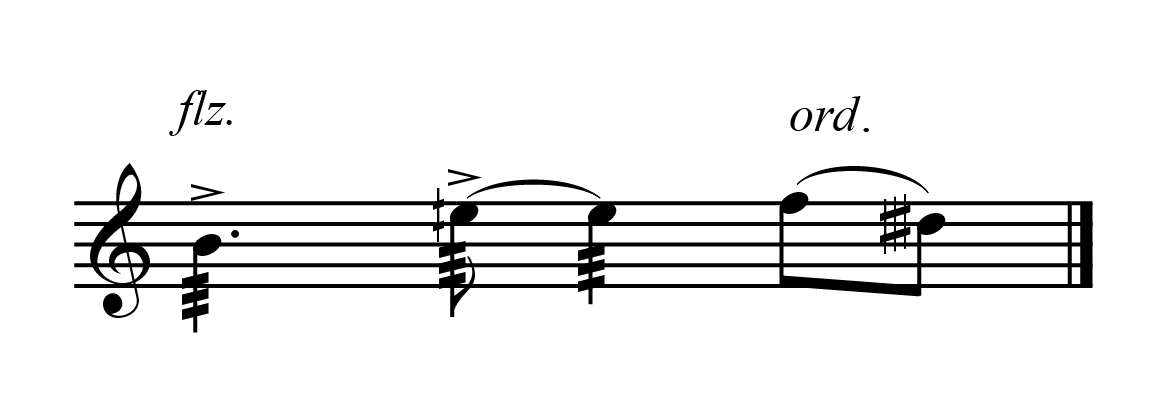Flutter tonguing
Flutter tonguing is a versatile technique which is effective at all dynamic levels and across the range of the instrument. Flutter tonguing can also be applied to a wide range of flute techniques, including multiphonics, trills, singing and playing and jet whistles.
Flutter tonguing may be produced either by the tongue or the uvula. Due to the physical differences between players, some find tongue flutter easy to execute, while for others it is completely impossible. Uvular flutter tonguing may be learnt, though it is initially difficult to control and requires considerable practice. It is advisable to check with the player to find out which method suits them best, and it is common practice for the player to dictate which method of production is used.
In the case of tongue-controlled flutter tonguing, the tongue may be placed in different positions in the mouth to harden or soften the articulation effect. As a result of the air angle and change in mouth shape for flutter tonguing, flutter tonguing in the lowest pitches of the bass flute is erratic, extremely difficult (although not impossible) and often contains an element of air in the tone. Results on these pitches can be variable according to the musical context and the type of flutter tonguing used and composers are advised to use caution in this area. To rearticulate a note, tongue-controlled flutter tonguing must be stopped and restarted after the note has been articulated. This is a time consuming and physically demanding process which can only be achieved at slow tempos. For this reason, it is most common for flutter tongued passages to be slurred.
Articulated flutter tonguing
Slurred flutter tonguing
Breathing and sustainability
Flutter tonguing requires a larger than normal volume of air to be used, as a result of alterations to mouth and embouchure position. Because of this, frequent breaths are required. The technique can also be fatiguing for the player, so it is advised to avoid long passages of flutter tonguing without rests.
Transition from normal playing to flutter tonguing
A seamless transition from normal playing to flutter tonguing with a gradually faster flutter tongue is only possible if uvular flutter is used, and can be difficult to master. For ease and more universal success, composers may consider moving through ribattimento effects, where a gradually accelerating double tonguing eventually becomes flutter tonguing. This can be achieved with either method of flutter tonguing without undue difficulty.
Ribattimento into flutter
Flutter tonguing with air and percussive sounds
Flutter tonguing can be incorporated into both air and percussive sounds for timbral variation. Pitched air sounds can be created through an opening of the embouchure aperture, creating a combination of air and tone which may be roughly specified by the composer (for example, through general directions such as the term 'airy', or in more specific ways, such as 70% air, 30% pitch), in a similar way to non-fluttered air sounds. A pure air flutter can be produced on any low register pitch, with the player blowing a diffuse air stream across the flute's embouchure hole.
Pure air flutter
A percussive flutter can be created by covering the embouchure hole in its entirety (with the flute rolled inwards towards the player to allow the hole to be covered) and flutter tonguing into the tube. Like other covered-hole effects, such as tongue rams and covered key clicks, the pitch is approximately a seventh lower than the notated fingering, although this varies according to the individual note and the internal mouth shape of the player.
Flutter tonguing into the flute
Notation of flutter tonguing
Flutter tonguing can be notated using the flz. symbol and tremolo markings. Cancel this out using ord.

Slurred flutter tonguing

Articulated flutter tonguing